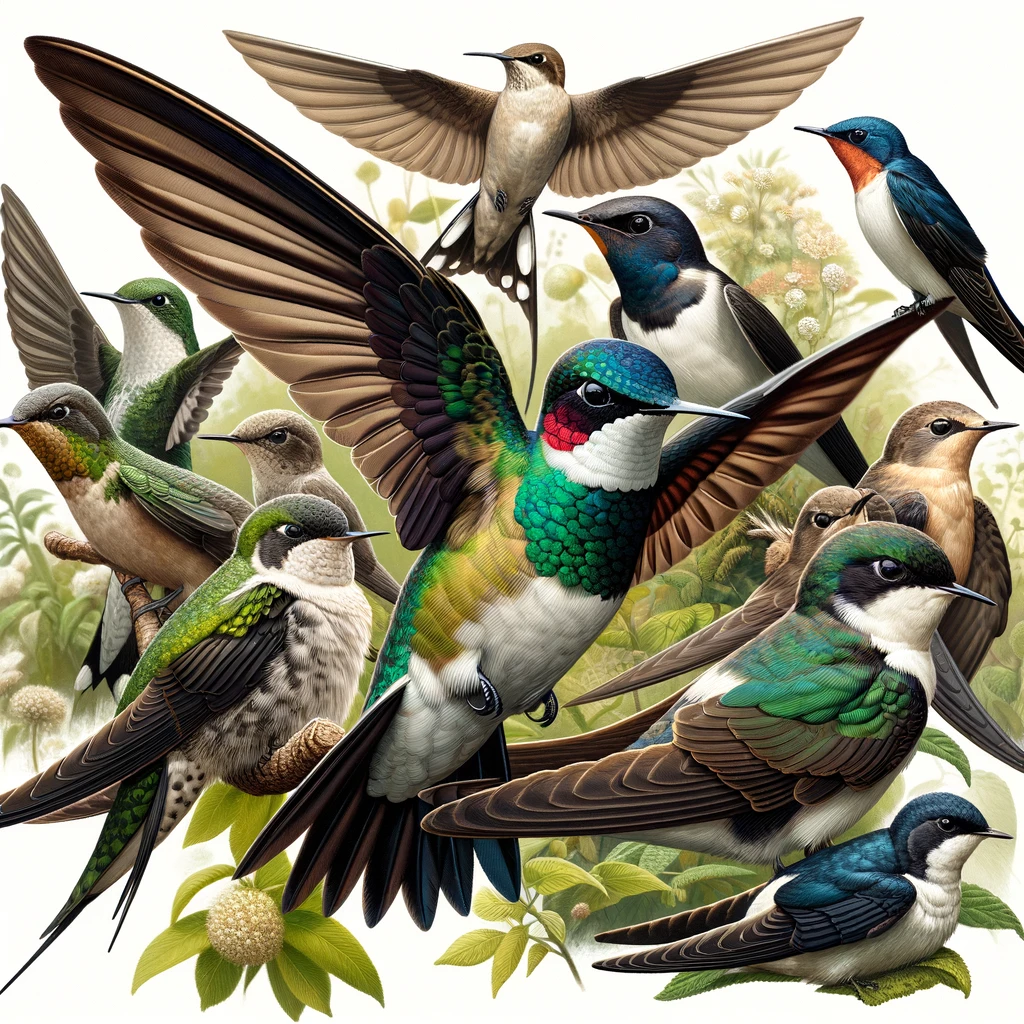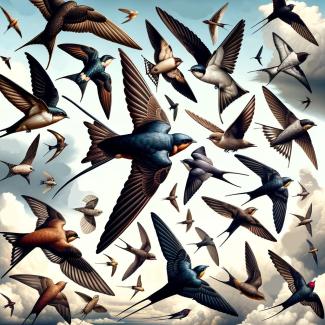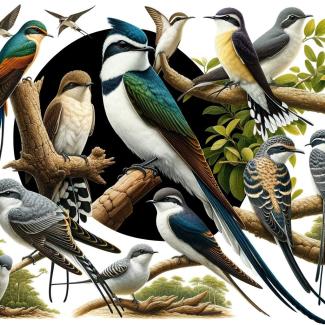
Encompassing swifts and hummingbirds, Apodiformes is a distinctive order of highly aerial birds adapted for life on the wing. With over 450 extant species, apodiforms display a global distribution across every continent except Antarctica.
United by aerodynamic lifestyles centered upon flight, the order traces origins stretching back 50 million years ago to primitive Tertiary species. Contemporary apodiforms demonstrate extensive adaptations facilitating their dazzling aerial mastery ranging from appropriately streamlined fusiform bodies and expansive wing-to-body ratios to highly efficient musculature powering nonstop beating of elongated wings.
While some species like hummingbirds possess unique features like reversible wrist joints and tongue tubes extending to tap suspended nectar, similar aerodynamic demands have shaped both swift and hummingbird orders over eons towards common capacity for effortless maneuverability and midair dining.
Apodiform flight talents allow the exploitation of immense three-dimensional aerial territories maximizing access to dispersed food resources often scarce on the ground.
Roosting and even mating while airborne, some apodiforms like alpine swifts may pass 98% of their lives aloft. Though parenting duties temporarily ground diminutive females, the dominance of flight across life history stages confirms apodiforms rank amongst the most aerially adapted of all birds.
Characteristics
Physical Features
Apodiformes share a suite of anatomical adaptations granting them supreme aerial agility. With slender, cigar-shaped bodies and short tails, swifts, and hummingbirds maximize aerodynamic profiles reducing drag. Wings are proportionally immense compared to tiny body weights ranging from 2 grams in bees and hummingbirds to 45 grams in larger swifts.
Plumage properties enhance flight performance as well. Smooth body feathering and stiff, rimmed flight feathers increase airflow efficiency. Some species exploit sexual dimorphic plumage – with males bearing iridescent throats or vibrant forked tail streamers used in mating displays.
Such ornamentations can even generate beneficial aerodynamic forces, like the split-ended tail feathers acting as an airbrake when hover-feeding.
Behavioral Traits
All swifts and hummingbirds possess powerful flight muscles comprising up to a quarter of their body weight. These allow wing-beat frequencies exceeding 80 beats per second in smaller hummers. Unique shoulder mobility lets wings rotate almost 180 degrees for optimum power in all directions. This facilitates unmatched maneuverability ranging from precise hovering in place to swift maximum speeds around 35 m/s in a stoop.
Feeding occurs entirely on the wing. Forked tubular tongues provide hummingbirds access to suspended nectars, while aerial insectivory dominates swift diets. Some Apodiformes even enter torpor or lowered metabolic states to endure colder evenings.
Reproduction and Lifespan
Performing nearly every life activity except nesting aloft, Apodiformes no longer land with grasping feet. Instead, they cling vertically to substrates using claw-tipped toes. Inconspicuous nests are affixed onto caves, crevices, or below overhangs out of reach of most predators.
Incubation lasts 15 to 30 days before altricial hatchlings emerge virtually featherless. Fledging follows another 20 to 50 days depending upon species. Maximum lifespans typically range between 5 to 12 years.
Extant families
Apodidae (swifts and treeswifts)
With over 100 species, the family Apodidae is confined to the Old World – mainly occupying Africa, Asia, Europe and Australasia. With aerial lifestyle prohibiting transoceanic dispersal to the Americas, Apodidae niches are filled by related hummingbirds on those continents. Despite some size differences, swifts share key traits like short legs, tiny non-grasping feet, expansive wing areas, and wide gapes for catching insects in midair.
Trochilidae (hummingbirds)
Endemic to the Americas, the family Trochilidae encompasses over 330 species - making it second only to tanagers among Western Hemisphere bird families. Exhibiting even more pronounced adaptations for aerial agility including reversible shoulders enabling intricate maneuvering, Trochilidae is further distinguished by specialized feeding mechanisms to access nectar.
Tubular tongues with fringed tips allow for lapping up sugar-rich liquids. Outwardly, iridescent plumage and incredibly diminutive dimensions define these dynamic aerialists.
Both families demonstrate mastery of powered flight and mid-air dining. But key differences exist between Old World swifts feeding exclusively on aerial insects versus New World hummingbirds tapping suspended flower nectars. Nonetheless, similar ecogeographic separation of ecological analogs supports adaptive evolutionary convergence shaped by shared life history constraints across hemispheres.
Global Distribution and Habitat
With over 450 extant species, Apodiformes have achieved a cosmopolitan distribution, inhabiting every continent except Antarctica thanks to supreme vagility unlocked by constant flight. Swifts occupy the Old World – mainly Europe, Asia, Africa, and Australasia. Hummingbirds flourish across the Americas from Alaska to Tierra del Fuego.
Such dispersal freedom permits occupying diverse habitats in pursuit of scattered food. Swifts frequent open areas near cliffs or vertical urban structures providing nest sites - ranging from deciduous forests to rainforest clearings to city centers. Most hummingbirds inhabit tropical zones rich in flowers – residing in cloud forests, scrublands, meadows, and even arid deserts in specialized nectarivorous species.
Some Apodiformes endure impressive altitudinal ranges as well thanks to the inherent ruggedness of lifestyle on the wing. For example, the Andean hillstar hummingbird breeds at elevations spanning 500 to 5200 meters in South America. Cold-hardiness adaptations like seasonal hypothermic torpor assist survival.
Yet despite occupying diverse landscapes, ideal Apodiformes habitat supplies two key features – extensive airspace permitting aerobatic flight maneuvers and sufficient food resources to fuel their unique metabolic demands. Fortunately, complex vertical spaces near blossoming plants or abundant flying insects characterize habitats across continents – granting Apodiformes extensive colonization opportunities worldwide.
Ecological Importance
podiformes provide valuable ecosystem services towards maintaining habitat stability. As aerial insectivores, swifts help regulate populations of flying arthropods. Formidable predators, individual swifts may consume thousands of termites, mosquitoes, beetles, and other nuisance species daily. This reduces annoyances to humans and grazing animals while limiting outbreaks of potential agricultural and disease-carrying pests.
Meanwhile, hummingbirds rank among key pollinators essential for sustaining plant communities. As they collect energy-rich nectars, incidental transfers of sticky pollen between blossoms ensure genetic exchanges. Such fertilization sets seeds to propagate wild plant range resilience. Approximately 15% of floral diversity in the Andes and Western North America relies upon hummingbird spread for propagation.
By accessing dispersed or patchy resources like ephemeral insects or scattered blooms, Apodiformes enhance biodiversity across fragmented terrain that proves inhospitable to less mobile fauna. And in concentrating abundant food for razor-honed hunters, mass cloud migrations of swarming army ants attract dozens of attending swifts which gracefully pick off escaping insects under the jungle canopy.
These important ecological contributions remind us that diminutive size pales against the outsized stability certain far-ranging species impart across ecosystems they perpetually patrol from dizzying heights.
Apodiformes in Specific Regions
Americas
Numerous hummingbird species occupy the diverse habitats of North, Central, and South America - from Ruby-throated Hummingbirds breeding in Eastern woodlands to Bee Hummingbirds, the world’s smallest bird, inhabiting Cuban forests. Many species like Anna’s Hummingbird thrive in urban gardens and parks.
Northern regions host migratory species while Andean foothills sustain specialist nectar feeders like the Sword-billed Hummingbird with beak lengths exceeding body size. Habitat loss threatens certain species but popularity in ecotourism and horticulture helps promote the conservation of these iconic species.
Europe
Famed for their epic migrations across Europe and Asia, Common Swifts nest abundantly in old buildings, castles, and bridges across much of Europe - returning faithfully to ancestral sites each spring. Once considered harbingers of summer, their arrival graces village skies accompanied by screams. Most European species remain widespread but some like Pallid Swifts concentrate in Southeast Europe and meet conservation challenges.
Asia
The Himalayan region sustains endemic species like the White-throated Needletail. Cave swiftlets in Southeast Asia build edible nests traded for Chinese medicinal bird’s nest soup. Many swifts occupy religious sites like Indian Minara where they are considered reincarnated ancestors.
In Indonesia, traditional feather amulets called funifuni feature Pied Swiftlets believed to promote healthy pregnancies. Residing largely in remote cliffs helped shield swifts from greater human pressures.
Globally Apodiformes generate tremendous appeal - gracing folklore tales for speed or alleged military applications while supporting ecotourism, conservation funding, and inspiring creative marvels at nature’s flight performance.
Conservation Challenges and Efforts
While many species remain abundant worldwide, Apodiforme's unusual life histories face growing threats in the coming decades. As of 2022, the IUCN Red List classifies nearly 100 Apodiformes species as vulnerable, endangered, or critically endangered. Small founding populations, dependence on patchy food sources, and narrow habitat niches create inherent vulnerabilities.
Habitat loss poses a serious concern, especially for specialized tropical forest hummers. Deforestation eliminates crucial nectar sources and perches. Even subtle microclimate alterations or extreme weather events enabled by climate shifts may reduce aerial insect density essential for swifts.
Other threats include nest disturbances from construction activities, mortality from human structures during concentration for migration or display, and predation by invasive species.
Addressing such threats grows increasingly urgent as the aerial masters deliver valuable ecosystem services like pest control and plant pollination. Promising initiatives for conservation exist - from swift towers in Europe to green spaces welcoming urban hummers.
Tracking studies detail migratory connectivity and habitat dependencies needing protection across hemispheres. Community nest site and roost stewardship empower preservation on local levels to sustain global populations.
More action is still needed to secure Apodiforme's remarkable talents into the future. But their universality and charisma find reflection in hearts worldwide. With due diligence, the dazzling denizens of dizzying heights will thrill children upwards for generations.
Conclusion
Apodiformes' remarkable aerial talents have captivated human observers across cultures for millennia. Beyond rich mythological symbolism tied to spectacular flight abilities, swifts and hummingbirds deliver valuable ecosystem services like insect regulation and plant pollination. Thereby they facilitate stability across fragmented landscapes linked by dispersed blooms or ephemeral food clusters only accessible to expert fliers.
Yet for all their magic as aerial masters, Apodiforme's extreme physiological investments into life on the wing carry inherent vulnerabilities as well. Small bodies, high metabolic rates, and complete aerial dependency make swifts and hummingbirds susceptible indicators to environmental shifts that disrupt phenological timing or food availability. Their future persistence relies upon maintaining intact ecosystems and eliminating disturbances to essential nesting and roosting sites.
Fortunately, public fascination grants Apodiformes diverse conservation allies. From bird watchers tracking migratory patterns to volunteers installing nest boxes in city centers, community members worldwide celebrate ephemeral hummingbird brilliance or classic swift screams gracing summer dusks. Global connectivity conservation must continue linking vital habitats across hemispheres to sustain these world travelers.
As urban green spaces expand floral resources, reduced pesticide usage allows swifts of ample insects across farmlands. With proper habitat stewardship, the dazzle of Apodiformes will continue gracing skies and imaginations for generations. Our collective commitment can keep their wizardry aloft.


